The concept of project management has gained massive popularity over the last two decades both in the private and public sectors. Sayigh (2018) defines project management as “the application of methods, processes, knowledge, experience, and skills to achieve success in a given activity. The project should be completed within a specific time and using a set amount of resources and a given number of employees. It is easy to assess the cost of a project because of these specific parameters, making it possible to compare benefits against the cost of the project. Project management has five distinct stages, irrespective of size or the organization undertaking it. They include initiation, planning, execution, monitoring of the performance, and the closure of the project (Müller et al., 2019). Each of these stages have specific criteria that must be followed to ensure that there is success.
It is important to explain essential features of project management at this stage of the report. One of the most important features is risk management. Spalek (2019) explains that it is necessary to identify and address all uncertain conditions which might affect the overall success of a project. Planning for these risks makes it easy to counter them. Resource management is another critical feature of project management. The manager must understand how to plan for and allocate resources available for the project in a way that eliminates wastes and unnecessary delays. Effective tracking of time is an essential feature of project management. Activities must be completed within a specific time based on the initial plan. Other important features include customized workflows, collaboration of individuals, delegation of tasks, and ease of use.
Types of Projects
Projects can be classified based on a number of factors such as their size, the sector which undertakes it, or the purpose for which it is conducted. In terms of size, projects can be classified as large or small projects. As the name suggests, a large project is one that cost more resources, takes long time to complete, and needs more human resource and is focused on addressing a major developmental issue. An example of a large project is the construction of the Dubai Metro. On the other hand, a small project focuses on addressing a minor developmental issue such as a small repair of a section of the Dubai Metro that is damaged. It takes a short period and require a relatively smaller resources compared with large projects (Sivaram, 2018). One can also classify a project as being public or private. A public project is one that is sponsored by the government and meant to address an issue that affects members of the society or a governmental entity.
On the other hand, a private project is sponsored by private companies or individuals for their benefit (Hillson & Simon, 2020). It is also possible to classify a project as being for-profit or non-profit project. When the government sponsored the expansion of the Dubai International Airport, it was a for-profit project meant to increase the capacity of the facility to help generate more income. On the other hand, when the government sponsors the construction of a public school, it is a non-profit project meant to enhance education in the country. Projects can also be classified as manufacturing projects such as New Boy’s manufacturing of toys, construction projects such as those conducted by Easa Saleh Al Gurg Group LLC, management projects such as those conducted by Boston Consulting Group, and research projects.
Brief Explanation of PLC Stages
When undertaking a project, irrespective of its size or purpose, it is important to understand the stages that has to be taken to ensure that the expected outcome is realized. According to Kulchawik (2018), there are five standard stages involved when undertaking a project. These stages are shown in figure 1 below. Understanding these stages helps in ensuring that all activities are conducted in a systematic manner and that the project manager and sponsors can assess the progress made with ease. The first stage is the conception of the idea and the initiation. Müller et al. (2019) observe that at this stage, the sponsor or owner of the project defines what needs to be done to address a specific concern or developmental issue within an organization. The project charter has to be defined at this stage to help define what needs to be done before the initiation process. The sponsor or owner of the project then hands over to the project management team.
The second stage is defined as project definition and planning. At this stage, the project management team defines the scope, budget, work breakdown schedule, a communication plan, and a risk management plan (Davidson, 2019). This is an important stage in the project because the team has to develop a comprehensive plan of how various activities will be conducted and how to deal with risks and issues that may emerge during the implementation process. It is at this stage that the project manager explains to the sponsor the budget, timeline of activities, and plans put in place to address different challenges. The third stage is the launch and execution of the activities. At this stage, the team is expected to carry out various activities as was defined at the planning stage. Activities such as key performance indicators, status tracking, quality assessments, and forecasts are regularly conducted at this stage. The project manager is expected to communicate with the sponsor and project owner regularly to make reports about the progress made and possible challenges encountered that may need their intervention.
The four stage, as shown in the figure below, is project performance and control. In some cases, this stage is often considered part of the execution process. When conducting the project, it is critical to conduct a regular assessment of the performance to ensure that everything is done as per the expectations of the stakeholders involved. The team will compare objectives set against the outcomes of activities conducted. Quality deliverables, cost tracking, and the overall performance is also evaluated at this stage. Performance assessment can be conducted by third parties not involved in the execution process or a section of employees of the company conducting the project. The assessment outcome may require the execution team to address issues that the team has identified with the project.
The last stage is project closure and handover. When the performance and control team is satisfied with the progress and activities conducted by the execution team, then the project manager can complete all the tasks as per the plan. When all activities have been completed, the project owner is expected to inspect the project to ascertain that everything is completed as per the expectations (Müller et al., 2019). When the owner is satisfied, the project manager will hand over the completed project, which would then result into the closure of the project.
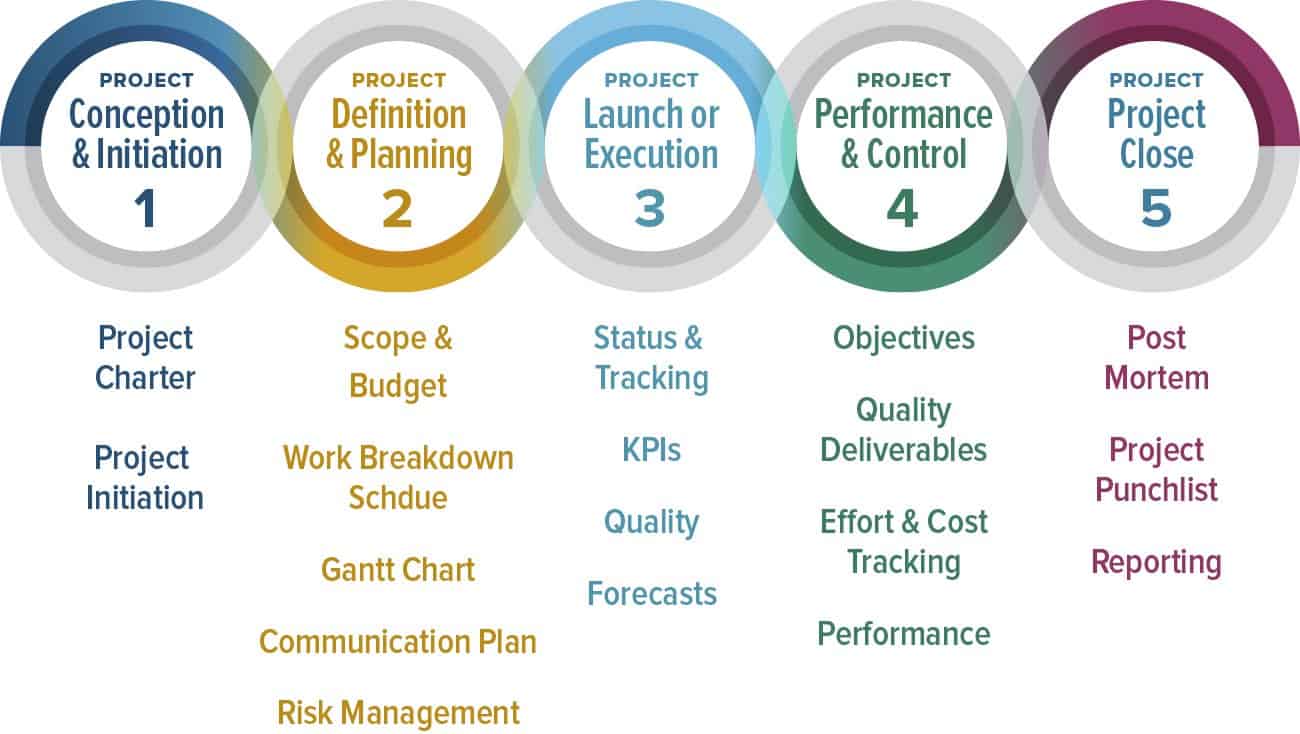
Application of Project Life Cycle Stages for the Selected Business
The discussion of project life cycle above has identified various stages involved when conducting a project. The figure above has identified various activities that have to be conducted at each of these stages. The selected project is the Dubai Metro Upgrade Project to meet the expanding needs of travelers in Dubai city. The city has been growing rapidly and the demand for transport services is also increasing. There has been a need to expand the capacity of the metro, and the Roads and Transport Authority (RTA) is committed to ensuring that this is achieved (Kulchawik, 2018). The project is meant to increase the capacity and reach of the metro system. The project life cycle concept will be applied in this project in four different stages discussed below, based on specific activities that have to be completed.
Feasibility Report and Business Case
The Dubai Metro Upgrade Project is expected to transform the transport system in the city. The project is expected to cost about $ 250 million. However, the financial benefits outweighs the cost significantly. Business across all industries will improve because of the ease of movement of passengers and goods. As Kerzner (2017a) observes, when conducting a feasibility study, it is important to ensure that the overall cost is less than the benefit. The business case below helps in explaining the financial benefit of this project to different sectors of the economy in the country.
Table 1: Business Case
Project Charter, Stakeholder Analysis, Gantt Chart, WBS
Table 2: Project Charter
The project manager and the entire team involved in the implementation process must understand how to manage the interest of different stakeholders in the project. The stakeholder map, shown in figure 2 below, helps in classifying these stakeholders. The first quadrant has stakeholders with high influence and high interest in the project. They include the project sponsors (government of Dubai) through its top officials. They have to be managed most thoroughly, ensuring that their expectations are met. The second quadrant has those with high influence but low interest. Senior government officials in other ministries other than the transport ministry are in this category.
The project management team should anticipate and manage their needs (Wysocki, 2019). The third quadrant has those with high interest but low influence. They include members of the public keen on using the services of the train once it is completed. They should be regularly informed about the progress of the project. The last quadrant has those with minimal interest and minimal interest in the project. They include visitors who come to Dubai for trade or tourism. They need to be given relevant information, especially when activities of the project will affect their stay within the city.
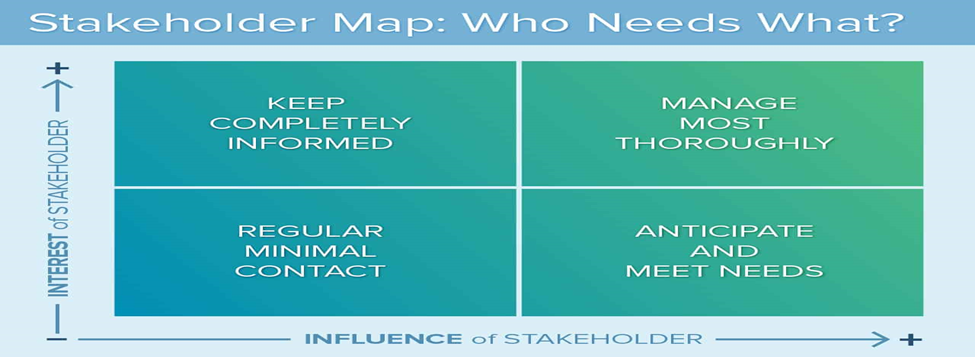
The project is expected to take 18 months, from March 1, 2021 to September 30, 2022. Each of these activities are expected to last for a specific period, as shown in Gantt chart of table 3 below. The conception and initiation process is expected to last 1 month because the need has already been defined. The process of defining and planning for the project will take two months. The launch and execution of the project, which is the main aspect of the project, will take 15 months. It will involve putting into practice the plan. Performance and control activities will last as long as the project is not completed, which means it will take 15 months. The owner will need two weeks to inspect the completed project and to ascertain that all needs are met. The last two weeks will involve handover process where relevant employees are assisted to know what is expected of them in the new project.
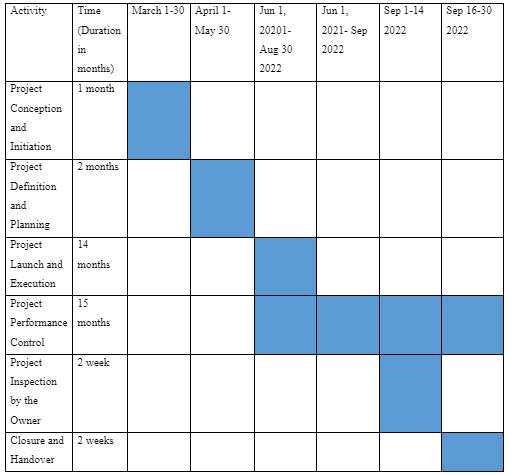
The work breakdown structure (WBS) shown in figure 3 below, identifies how activities are broken down in each of the categories to ensure that the upgrade of the Dubai metro is a success. WBS makes it easy to identify specific activities that have to be completed within a specific period to achieve a given goal.
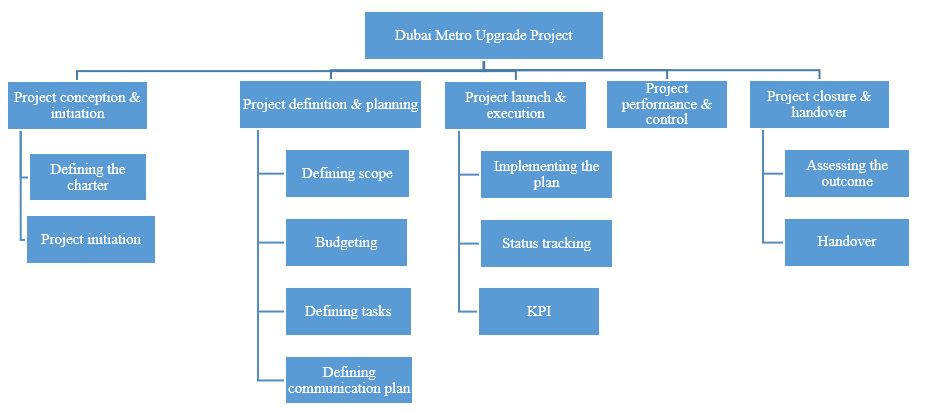
Identify KPI, Milestones, Deliverables, Targets, Benchmarks
The third stage in the PLC involves identifying the key performance indicators, the milestones, deliverables, targets, and benchmarks. They help in defining the progress that is made in the implementation plan. Each of these factors are discussed in details in the section below.
Closure and Review the Project Performance
When all the activities have been completed as per the plan, the last face is the closure and the review of the project performance against the parameters that had been set at the planning stage. The project owner will review the outcome to determine if the intended goals have been realized. In this project, the team will conduct a quality assessment of the expanded metro system to ensure that it is capable of sustaining the new demand.
Milestones, Deliverables, Targets, Benchmark, KPI for the Project
Milestones helps in marking specific points along the timeline of a project. In this Dubai metro upgrade project, the milestones have been classified in five main stages. The first is the inception and initiation of the project that will be done by the government of Dubai. The second stage is project definition and planning which is done by the contractor in close coordination with the project owner. The third milestone is the actual implementation of the plan where various construction activities. The fourth milestone is the project performance and control. The last milestone will be project closure and handover where the government is expected to take control of the metro system after its expansion.
Upon the completion of the completion of the project, the contractor is expected to hand over deliverables to the project owner. In this upgrade project, the deliverable will be the additional railway lines and the additional trains that are expected to expand the capacity of the metro system. The new railway line and the trains must meet the expectations of the government as defined in the plan. The primary target is to ensure that the Dubai metro’s capacity is expanded by the end of the 18 month period provided for the project. The additional system should be integrated seamlessly with the existing system.
Benchmarking will be an effective approach of enhancing the performance of this project. The team can select one of the best metro systems in the world that has gone through various stages of the upgrade and use it as an example that should be embraced. Hong Kong’s mass transit railway has been regarded as one of the most efficient and environmentally clean metro capable of supporting the ever increasing population in the city (Kerzner, 2017b). The project management unit can use it as a benchmark for the Dubai metro upgrade project.
When conducting this project, the project manager and the entire team will need to be guided by specific performance indicators. The first indicator of effective performance is timeliness. Each of the activities in this project has been assigned a specific period within which they have to be completed. The team must ensure that each activity is completed on or before the due date. Delays often cause an increase in the overall cost of the project (Müller et al., 2019). The time set for the entire project is 18 months. Quality is another major performance indicator that the team has to take seriously. When making an effort to complete activities at the right time, quality should not be compromised.
The team must ensure that the right material is used in the right way to achieve excellent results based on the specifications of the client. Budget is the third indicator that this time should be careful about. It is common to find cases where a project is hit by a deficit because of issues such as theft, misuse of materials, or unnecessary delays, which subject the project inflation. Such challenges should be addressed effectively in this project. The last key performance indicator is the overall effectiveness and performance of the completed project. The additional system should increase the capacity of the Dubai metro.
Rationale for the Project Methodologies and Tools: Agile Approach in PLC
When conducting a project, it is always important to define it in terms of size. One has to understand the difference between small and large projects. Large projects often involve intensive activities that may take months or years to complete and usually have large teams working on them. On the other hand, small projects minor developmental activities taking weeks or a few months to complete using small teams. A project manager needs to understand theories, concepts, and models that are relevant in completing the assigned tasks successfully. The rationale of defining such theories or concepts is that it enabled the project management team to understand the assumptions that they need to make when planning for specific activities. In this project, agile methodology or concept was selected as the appropriate concept for the Dubai metro upgrade project. Figure 4 below identifies the stages or principles involved when embracing this concept.
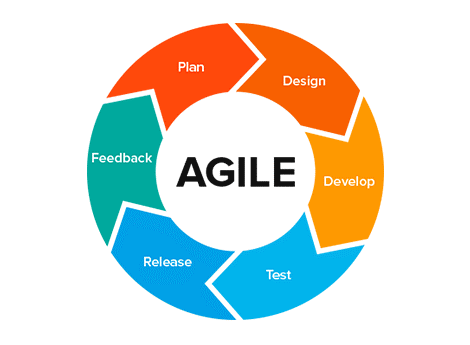
The first stage is the planning process where the team identifies activities to be undertaken and assigns specific individuals different tasks at various stages of the project. The next phase is the design process, where the team develops a blueprint of the construction. In this specific project, the design had to be aligned with the current design of the Dubai metro system. The design is developed by the contractor but approved by the client. The third stage is the development, where the design is implemented to achieve the desired goals. In PLC, the development phase is the actual execution of the project. The next stage is testing of the outcome to determine whether it meets expectations. If it does, the team will move to the next phase of the release where the completed project is handed over to the owner. The team gets a feedback that defines the approach that they will take in future projects.
Significance of Project Leadership for the Business
Project leadership is crucial for the success of the intended project. Upgrading Dubai metro is a major project that will have a major economic implication. It is possible that during the various stages of the implementation, the normal usage of the system may be interrupted to facilitate work. The project manager, who will be the leader in this project, will have the responsibility that everything is done within the right time and in a way that causes minimal interference possible. Internally, the manager will provide leadership that workers need to achieve the desired success (Ahmad, 2018). The leader will be expected to maintain a team of highly skilled and self-motivated workers. Whenever an issue arises that affect one or more of the employees, it should be addressed as soon as possible and in the right manner. The leader will coordinate all the internal activities to ensure that the project is a success.
The project manager is also the link between external stakeholders (the government, members of the public, and other interested parties) and internal stakeholders (workers) in the project. The leader has to make a regular communication with these external stakeholders, explaining the progress and discussing any challenge that might arise in the implementation process. Whenever members of the public has a demand that needs to be addressed, the project manager must coordinate with members of the team and ensure that the issue is addressed in the most effective way and within the shortest period possible. Without the guidance of the project manager, it may be challenging to coordinate activities during the upgrade process.
Post-Implementation Review Process Using PLC
When the project has been completed, it is always necessary to conduct an evaluation to determine if every activity was completed as per the expectations. Kulchawik (2018) explains that post implementation review process should be based on the stages of project life cycle. The conception and initiation process is often conducted by the project owner. The review involves defining how well the owner has conceived what needs to be done and the initial engagements with the contractor. The second stage involves definition and planning process. Success at this stage is based on how well various activities in the project are defined, including time that should be taken, the budget, and individuals who will be responsible for various tasks. The plan needs the approval of the project sponsor.
The next stage is the launch and execution of the project. The review will focus on how effectively the approved plan is implemented and whether the intended goal was achieved. The assessment will also focus on determining whether these activities are completed within the initial budget. Issues about quality is prioritized at this stage. The fourth stage involves project performance and control. The review should focus on determining whether the performance review was conducted as per the specific standards. The last PLC stage is the closure and handover. The review will assess how effective this process was conducted. The Dubai metro employees should be capable of managing the system with ease upon its completion.
Review of the Project Performance
Reviewing the performance of the project can be conducted using various strategies. Barrett (2018) explains that in mega projects that are financially involving, it is critical to assess the progress at different stages of implementation to avoid cases where costly mistakes are identified late when the project is almost completed. Using milestones, deliverables, targets, benchmark, and key performance indicators, the government of Dubai can conduct an effective assessment of the project.
Milestones
The assessment can be based on the milestones of the project. In this case, the team will be assessing the success of the project whenever a given milestone is achieved in the project. In this upgrade project, there are numerous milestones set based on the activities that are to be conducted. The assessment team will assess how each activity has been conducted (Kerzner, 2018). The goal is to ensure that before the team can move to the next milestone, the current activity has to be completed as per specific expectations. This review approach is always effective because it eliminates cases where a major mistake is noticed at a later stage in the project.
Deliverables
The review of the project performance can also be conducted based on the deliverables. The project owner can wait for the outcome of the project then assess it based on the goals that it needed to achieve (Hillson & Simon, 2020). The project has two main deliverables that can be assessed based on the predetermined criteria. The first deliverable is the new railway line that is meant to expand the reach of the metro system. The second deliverable is the new trains that will be used in the expanded metro system. The government, as the sponsor and owner of the project, can assess these deliverables upon the completion of the project to determine if they meet the set expectations. The danger of conducting a review of project performance at this stage is that it may be costly to make adjustments at this stage. Although it is a standard practice to review the deliverables, it is important to ensure that stage by stage reviews are also conducted to ensure that mistakes can be corrected as early as possible.
Targets
The project owner may opt to conduct a review of the project performance based on targets. In this case, the team will need to set specific goals (targets) that have to be met at various stages of the project. Upon completion of each of these stages, the team will determine whether the intended goal was realized before moving to the next. The progress of the project will depend on the ability of the team to achieve specific goals at various stages of the project life cycle.
Benchmark
Benchmarking was also identified as one of the approaches that can be used to complete a project. When it is used, an assessment process is needed that will help in ensuring that the intended goal is desired. The project owner can rely on the plan of the benchmarked project and use its standard assessment procedure to conduct the review. An alternative would be to develop internal reviews, based on the desired outcome of the project. Rao (2018) explains that problems often arise when the project owner or the team involved in the implementation cannot develop an effective review strategy based on the benchmarked project. The goal is always to have an outcome that is similar to the one that was copied.
KPI
Key performance indicators can also be used to conduct a review of project performance. In this project, timeliness was identified as one of the key performance indicators. The review of the performance can be conducted by assessing the timeliness in the completion of each of the activities in the project. Any delays will be an indication of a problem in the project. Quality was another major indicator of performance. The assessment team will need to assess the outcome of every individual activity and ascertain that the level of quality that is expected is met. Any necessary adjustments should be made at earlier stages of the project. Budget was the third indicator of performance. The team responsible for the review may assess how effectively resources were spent in the project.
Importance of Reliability and Validity in Project Evaluation
When conducting project evaluation, it is important to understand the significance of reliability and validity of the process. The upgrade of the Dubai metro is an important project meant to boost the economy of the emirate and the country at large. As such, it will require an accurate evaluation at every stage of the PLC. Each activity must be accurately evaluated because of the implication of the outcome and the fact that this plan may also be used in defining other mega future projects. Reliability and validity of the evaluation process can be guaranteed by ensuring that standard assessment procedures are used. The government, as the sponsor and owner of the project, should have a standard procedure of assessing such projects. The assessment procedure should be simple but based on strict policies and standards set by the government.
In this project, agile theory of project management was used to help define the methodology needed by the team to enhance the success of the activities involved. This method was considered effective because of its reliability. It defines specific steps that the team should follow to ensure that the project is a success. The stages defined in this theory are simple but effective when conducting such a project. The following are recommendations for improvement that such similar projects should embrace when conducting an evaluation:
- The evaluation process should be based on specific standards that is set by the project sponsor and owner;
- The evaluation process should be simple and specific yet capable of ensuring that project goals and objectives are realized;
- When using benchmarking, the evaluation process may need to be based on principles that were embraced by the benchmarked project;
- The project owner should delegate the role of evaluating the project to experts who can easily identify shortcomings of the project outcome.
References
Ahmad, M. (2018). Operation and control of renewable energy systems. John Wiley & Sons Publishers.
Barrett, C. (2018). Understanding project management: A practical guide. Canadian Scholars Press.
Davidson, J. (2019). Everyday project management. Berrett-Koehler Publishers.
Hillson, D., & Simon, P. (2020). Practical project risk management: The ATOM methodology. Berrett-Koehler Publishers.
Kerzner, H. (2017a). Project management metrics, KPIs, and dashboards: A guide to measuring and monitoring project performance. John Wiley & Sons.
Kerzner, H. (2017b). Project management: Case studies. Wiley.
Kerzner, H. (2018). Project management best practices: Achieving global excellence. John Wiley & Sons.
Kulchawik, L. (2018). Trade shows from one country to the next: A guide to recalculate your thinking when marketing in multiple countries. Page Publishing.
Müller, R., Drouin, N., & Sankaran, S. (2019). Organizational project management: Theory and implementation. Edward Elgar Publishing.
Rao, K. (2018). Wind energy for power generation: Meeting the challenge of practical implementation. Springer International.
Sayigh, A. (2018). Transition towards 100% renewable energy: Selected papers from the world renewable energy congress WREC 2017. Springer.
Sivaram, V. (2018). Taming the sun: Innovations to harness solar energy and power the planet. The MIT Press.
Spalek, S. (Ed.). (2019). Data analytics in project management. Taylor & Francis Group.
Ward, G. (2018). Effective project management: Guidance and checklists for engineering and construction. John Wiley & Sons.
Wysocki, R. (2019). Effective project management: Traditional, agile, extreme. John Wiley & Sons.
